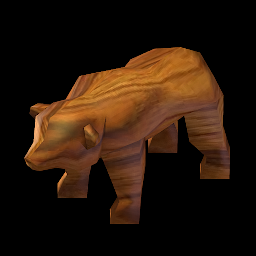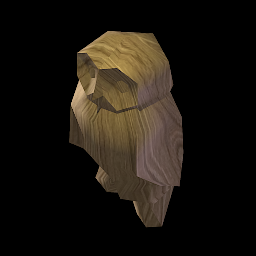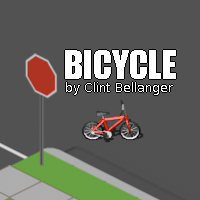Using item flavor to tell stories
In text adventure games of yore, game designers couldn’t rely on images to communicate each item to the player. Instead it was common to Inspect an item to get a textual description of it.
In fantasy there’s a common trope of mystical magic items with hidden names or powers. In The Hobbit, Elrond recognized the Elvish weapons Orcrist, Glamdring, and Sting and explains the stories and powers behind them. In Diablo, the mage Deckard Cane identifies magic items for the hero. In D&D there is a traditional magic spell that can reveal the properties of enchanted items.
This combination of game mechanic and fantasy tradition is still evident in games today. Many fantasy games include a “Flavor” description of objects or powers. By “Flavor” I mean text that is about story and color, not about specific game mechanics. We see this distinction clearly in Magic: The Gathering where flavor text on cards is in italics to denote that it isn’t part of the card’s actual game rules.
In video games, sometimes these descriptions merely detail the item itself — physical details that aren’t obvious from the icon or 3D model, or a more creative explanation of its in-game function. But creative game writers use item descriptions to tell more about the game world. Items can refer their areas of origin, or to a famous former owner, or to an historical event.
The recent games Demon’s Souls and Dark Souls use item descriptions masterfully. These games have very little exposition and dialog but still manage to convey rich, deep worlds. Items actually tell much of the story; their flavor texts hint at the larger world that can’t be seen. This is especially effective in Action RPGs where a player doesn’t need to be bogged down by heavy dialog or told a long story. Curious players who crave story can read all the item descriptions and discover (or infer) the larger game world at their own pace.
I’ve been so influenced by the Souls games that I want to do the same for Flare. I’m doing it in a backwards (I think) way though. I’m not a writer; I don’t have a volume of creative notes about the world that Flare takes place in. Instead I’m creating item descriptions that I feel are resonant, and sort of building/discovering the world as I go.
Because I’m not a writer this task is turning out to be far more challenging than I expected. Good flavor text needs to be concise — one or two lines at the most. It should lend the feeling to the game world, so I’m trying to avoid overt pop culture references or too much breaking of the 4th wall (though other games with different tones can and do include those things). Finally I need to mind the fine line between pretentious and boring. But my goal is to have every item tell a tiny story.
Items in progress
Last Rites
Effect: this weapon deals double damage to Undead
Flavor: When the Warpriests of Sceleris began their mercy killings, they used these morning stars on the most faithful parishioners first.
This was the first item I created in this new style. Here the item hints at a historical event in the game world — some undead outbreak. I particuarly like this text because of the oxymoronic nature of the terms: “war priest”, “mercy killings”, etc. It heavily implies the event was not a clear cut “good”. Holy men butchering villagers to stave off an undead plague is a moral quagmire.
It may be that such an event is cliche. I’m reminded of Arthas’ purging of Stratholme in Warcraft lore. But we’re not forcing the player to dwell on the event — just giving them a taste and letting them fill out the details themselves.
Originally I used the phrase “Warpriests of Sceleria”. I changed it after making the next item, as you’ll see.
Thief Gloves
Effect: you loot more gold from defeated enemies
Flavor: “In Lower Sceleris there is honor among thieves. Everyone else is a mark.
There’s no set place in the game named Sceleris, not yet anyway. This just implies somewhere in the game’s world there is such a place, and it is probably a hive of scum and villainy.
When naming “Lower Sceleris” I needed a fantasy name that sounded like a dangerous area or city. I started with “Sceleria” only because it had an interesting fantasy sound. By luck I found out that the similar form “Sceleris” is actually a Latin word that has something to do with crime or villainy. The player probably won’t know that, but it’s a nice touch of flavor. Adding “Lower” pushes the idea that it’s a lesser or poorer part of town.
I like the flavor implication that there may be a Thieves’ Guild operating in Sceleris. Action RPGs aren’t usually the kind of game that needs political intrigue or guilds, but it makes an interesting backdrop nonetheless. It also makes an easy opening for quest lines or NPCs later.
Boots of Speed
Effect: you run faster
Flavor: These enchanted boots are prized possessions of Courier guildsmen.
I must have been intrigued by the idea of guilds, because I outright named one in the next item. A Courier guild is great in a dangerous fantasy world. Or at minimum it gives some grounding to fetch/delivery quests that are easy to implement.
I had been playing with the phrase “prized possession” when writing up several items and decided I needed a good spot to use it. It makes a lot of sense here — running quickly means you can avoid danger and deliver items more efficiently.
This also opens up easy places to award the treasure — slap it on a dead body along with some other package. Now there’s a story in the environment instead of explained in words. And perhaps the hero can take the package to its destination.
Ashwood Wand
Effect: small bonus to magical power
Flavor: The secrets to harvesting Yggdrasil twigs are known only to traitorous dryads.
This item didn’t need to be some majestic artifact; just a nice “my first magical equipment” for mage characters.
This flavor continues my theme of favoring dark and twisted stories. I enjoy the idea that evil tree spirits are trading away parts of the World Tree for personal gain. Every twisted reference we drop into the game adds to the setting and atmosphere.
The Yggdrasil is a Norse reference, but I think it’s obscure enough to pass here. I was concerned whether people too familiar with Norse mythology would find the reference silly. But fantasy already borrows so heavily from old mythology that it’s probably fine. If it really bugs me later I can just rename the tree.
Lawman’s Sidearm
Effect: small bonus to melee combat
Flavor: The workmanship on this blade appears hurried, as if forged under the fever of vigilance.
Here’s an item description that mainly details the history of this single item. Some lawful person, or possibly a vigilante, crafted this weapon to fight the chaos. It doesn’t say whether it was used in self defense, or as a makeshift badge, or to slay criminals, or to fight some abstract cause. Any of those options are possible and that makes the item interesting.
The name of this item is almost anachronistic — sounds more like an Old West revolver than a dagger. But I like that feeling; I want the settings of the game to almost feel like the frontier West. In future games based on Flare I plan to experiment with more overt anachronistic stories.
Strategies
I’m mainly writing out this blog to meta-think about the strategies I’m using to come up with flavor texts. Here are some options I’m seeing just in these first few items, plus a few more thrown in that I want to use later.
- Reference to a historical event
- Reference to a historical person or previous owner
- Reference to location (region, city)
- Reference to factions or organizations
- Physical or usage detail of the item
- History of how the item was made
- Foreshadowing?
- Set up a quest or game event?
Hopefully this out-loud thought process is helpful or insightful to someone else. I’m trying to get better at various facets of game design and writing definitely isn’t my strong suit. Side note, I’m considering creating a text-heavy One Game A Month entry for February for more practice.





